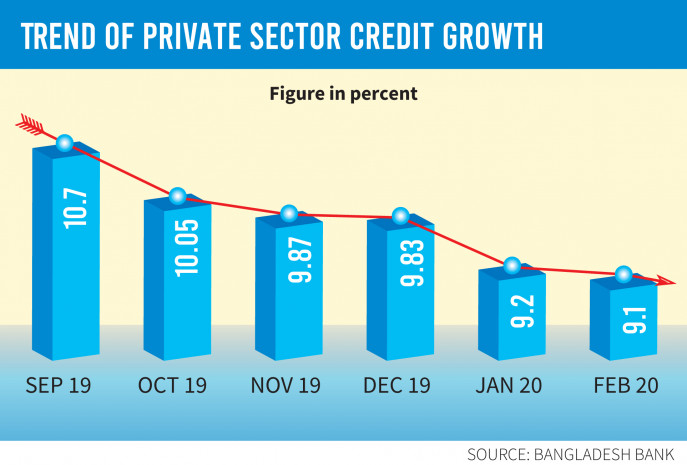SAM
Published:2020-03-25 18:54:17 BdST
Virus worsens private credit growth in February
FT ONLINE
Although banks are awash with excess liquidity, private sector credit growth continued its downward trend for five consecutive months till February, reflecting the stagnancy in business expansion.
Credit growth to the private sector dropped slightly to 9.1 percent in February from 9.2 percent in the previous month, according to Bangladesh Bank data.
Imposition of the single-digit lending rate made banks reluctant to lend, causing a slump in private sector credit growth in recent months, said Faruq Mainuddin Ahmed, managing director of Trust Bank.
"The outbreak of coronavirus has led to stagnation in business expansion, worsening credit flow to the private sector," he said.
He added that the spread of coronavirus has created uncertainty about how long the situation will continue. As a result, the crisis in the private sector will further deepen in the coming days.
Government borrowing, which had been on an unusual rise even two months ago, slowed down in February with the Covid-19 outbreak.
Government borrowing declined by Tk2,000 crore to Tk50,600 crore in March from Tk52,000 crore in February, according to central bank data.
However, the borrowing amount is 7 percent higher from the Tk47,364 crore government target for the entire fiscal year.
The interruption in the implementation of government projects amid the pandemic has slowed down borrowing from the banking system, said, industry insiders.
Work on a re-powering of the Ghorashal power plant's fourth unit has slowed down in the absence of Chinese staff, who remain stranded in their country amid the outbreak.
The workers, who had gone back home in January to celebrate the Chinese New Year, are not allowed to leave the country now.
Many other projects are going through the same crisis.
The projects which are underconstruction with funds from China and involve Chinese engineers and experts will be affected the most.
Big projects such as the Padma Bridge, the Padma Rail Link, the Karnaphuli Road Tunnel and the Greater Dhaka Sustainable Urban Transport Project (BRTA, Gazipur-Airport) are among them.
The construction of a combined cycle plant under the Ghorashal power project is now at the final stage but its pace has slowed down due to the absence of key experts.
Though lending activities remain at a standstill, the tendency of withdrawing money has been rising among people over growing concerns of a lockdown in the city.
The Bangladesh Bank has already taken a series of measures to tackle a possible cash shortage in banks brought on by the pressure of withdrawals.
In a circular issued on Monday, the central bank reduced the repo rate by 25 basis points to 5.75 percent and cash reserve ratio (CRR) by 50 basis points to 5 percent a year.
Both repo rate and CRR have been slashed to increase availability of cash in the banking system.
Repo rate, also known as the policy rate, is the central bank's lending rate for commercial banks.
Currently, the repo rate is 6 percent and the average inflation in February stood at 5.60 percent.
On the other hand, the reduction of CRR – the amount banks have to keep with the central bank as reserves – will save cash for banks to invest.
Banks now have to set aside 5.5 percent of clients' deposits as CRR.
Two years ago on April 4, 2018, the central bank cut CRR by one percentage point to 5.5 percent, helping the banking system to have an additional Tk20,000 crore in hand.
Currently, the banking sector is sitting on excess liquidity of more than Tk1 lakh crore, invested mostly in government bills and bonds.
Unauthorized use or reproduction of The Finance Today content for commercial purposes is strictly prohibited.


